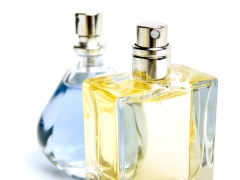Perfume
| Infobox on Perfume | |
|---|---|
| Example of Perfume |  |
| Facts | |
| Origin | - |
| Stowage factor (in m3/t) | 2,12/1,41 m3/t (cases) |
| Humidity / moisture | - |
| Ventilation | - |
| Risk factors | See text |
Perfume
Description / Application
Perfume is a blend of pleasantly odorous substances (usually liquids) obtained from the Essential Oils of flowers, leaves, fruit, roots, or wood of a wide variety of plants, either by steam distillation or solvent extraction. Flower oils (rose, jasmine) are extracted with a non-polar solvent to give a waxy mixture called a concrete; the wax is then removed by a second solvent (an alcohol), which is then in turn removed to form an absolute. It is necessary that all the solvent be eliminated to obtain the finest perfumes. The centre of this industry has long been in Grasse, France. Perfume materials are also derived from animal sources (musk, ambergris) and from resinous extracts (terpenes and balsams); they are also made synthetically. Cologne and toilet water are weak alcoholic solutions (5% or less) of perfumes. Fine perfumes may contain as many as 30 ingredients and their blending is an art rather than a science. The largest volume use of perfumes is in soaps, lotions, shaving creams, and cosmetics.
The precise formulae of commercial perfumes are kept secret. Even if they were widely published, they would be dominated by such complex ingredients and odorants that they would be of little use in providing a guide to the general consumer in description of the experience of a scent. Nonetheless, connoisseurs of perfume can become extremely skillful at identifying components and origins of scents in the same manner as wine experts.
Fragrance compounds in perfumes will degrade or break down if improperly stored in the presence of:
- Heat
- Light
- Oxygen
- Extraneous organic materials
Proper preservation of perfumes involves keeping them away from sources of heat and storing them where they will not be exposed to light. An opened bottle will keep its aroma intact for several years, as long as it is well stored. However the presence of oxygen in the head space of the bottle and environmental factors will in the long run alter the smell of the fragrance.
Perfumes are best preserved when kept in light-tight aluminium bottles or in their original packaging when not in use, and refrigerated to relatively low temperatures: between 3-7°C. Although it is difficult to completely remove oxygen from the headspace of a stored flask of fragrance, opting for spray dispensers instead of rollers and "open" bottles will minimize oxygen exposure. Sprays also have the advantage of isolating fragrance inside a bottle and preventing it from mixing with dust, skin, and detritus, which would degrade and alter the quality of a perfume.
There exist several archives and museums devoted to the preservation of historical perfumes, namely the Osmothèque, which stocks over 3,000 perfumes from the past two millennia in their original formulations. All scents in their collection are preserved in non-actinic glass flasks flushed with argon gas, stored in thermally insulated compartments maintained at 12°C in a large vault.
Shipment / Storage / Risk factors
Usually shipped in bottles, inside cartons. Require sound stoppering when bottled for shipment to or through high altitudes. Leakage arises from plastic covers having insufficient ‘cushion’ within the stopper, and lack of tightening up. If breakage of one or more bottles occurs, labeling on undamaged bottles will be adversely affected by the chemical content of the product.
For overseas carriage reference is made to the relevant IMO regulations on hazardous cargo (IMDG Code; flammable liquid) and the applicable MSDS sheet.











